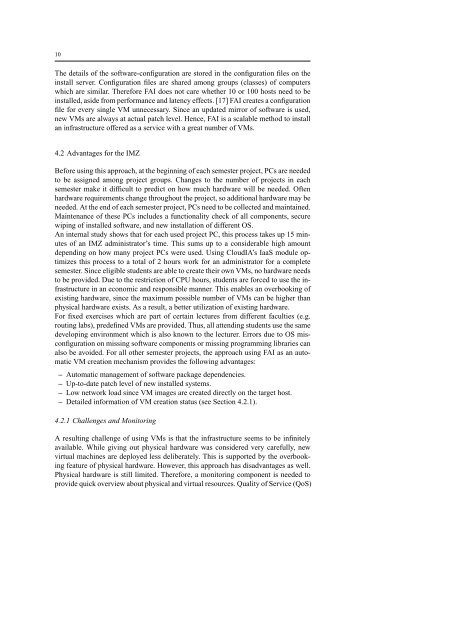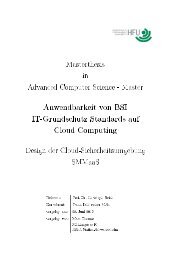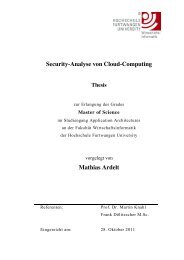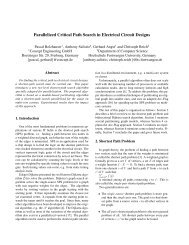Private Cloud for Collaboration and e-Learning Services: from IaaS ...
Private Cloud for Collaboration and e-Learning Services: from IaaS ...
Private Cloud for Collaboration and e-Learning Services: from IaaS ...
Create successful ePaper yourself
Turn your PDF publications into a flip-book with our unique Google optimized e-Paper software.
10<br />
The details of the software-configuration are stored in the configuration files on the<br />
install server. Configuration files are shared among groups (classes) of computers<br />
which are similar. There<strong>for</strong>e FAI does not care whether 10 or 100 hosts need to be<br />
installed, aside <strong>from</strong> per<strong>for</strong>mance <strong>and</strong> latency effects. [17] FAI creates a configuration<br />
file <strong>for</strong> every single VM unnecessary. Since an updated mirror of software is used,<br />
new VMs are always at actual patch level. Hence, FAI is a scalable method to install<br />
an infrastructure offered as a service with a great number of VMs.<br />
4.2 Advantages <strong>for</strong> the IMZ<br />
Be<strong>for</strong>e using this approach, at the beginning of each semester project, PCs are needed<br />
to be assigned among project groups. Changes to the number of projects in each<br />
semester make it difficult to predict on how much hardware will be needed. Often<br />
hardware requirements change throughout the project, so additional hardware may be<br />
needed. At the end of each semester project, PCs need to be collected <strong>and</strong> maintained.<br />
Maintenance of these PCs includes a functionality check of all components, secure<br />
wiping of installed software, <strong>and</strong> new installation of different OS.<br />
An internal study shows that <strong>for</strong> each used project PC, this process takes up 15 minutes<br />
of an IMZ administrator’s time. This sums up to a considerable high amount<br />
depending on how many project PCs were used. Using <strong>Cloud</strong>IA’s <strong>IaaS</strong> module optimizes<br />
this process to a total of 2 hours work <strong>for</strong> an administrator <strong>for</strong> a complete<br />
semester. Since eligible students are able to create their own VMs, no hardware needs<br />
to be provided. Due to the restriction of CPU hours, students are <strong>for</strong>ced to use the infrastructure<br />
in an economic <strong>and</strong> responsible manner. This enables an overbooking of<br />
existing hardware, since the maximum possible number of VMs can be higher than<br />
physical hardware exists. As a result, a better utilization of existing hardware.<br />
For fixed exercises which are part of certain lectures <strong>from</strong> different faculties (e.g.<br />
routing labs), predefined VMs are provided. Thus, all attending students use the same<br />
developing environment which is also known to the lecturer. Errors due to OS misconfiguration<br />
on missing software components or missing programming libraries can<br />
also be avoided. For all other semester projects, the approach using FAI as an automatic<br />
VM creation mechanism provides the following advantages:<br />
– Automatic management of software package dependencies.<br />
– Up-to-date patch level of new installed systems.<br />
– Low network load since VM images are created directly on the target host.<br />
– Detailed in<strong>for</strong>mation of VM creation status (see Section 4.2.1).<br />
4.2.1 Challenges <strong>and</strong> Monitoring<br />
A resulting challenge of using VMs is that the infrastructure seems to be infinitely<br />
available. While giving out physical hardware was considered very carefully, new<br />
virtual machines are deployed less deliberately. This is supported by the overbooking<br />
feature of physical hardware. However, this approach has disadvantages as well.<br />
Physical hardware is still limited. There<strong>for</strong>e, a monitoring component is needed to<br />
provide quick overview about physical <strong>and</strong> virtual resources. Quality of Service (QoS)





